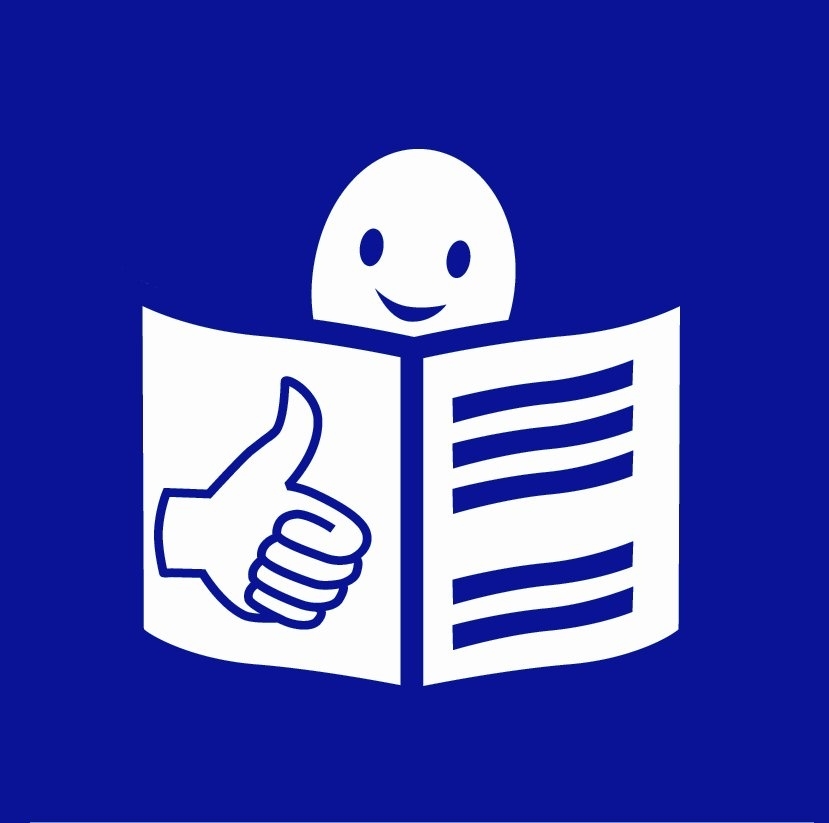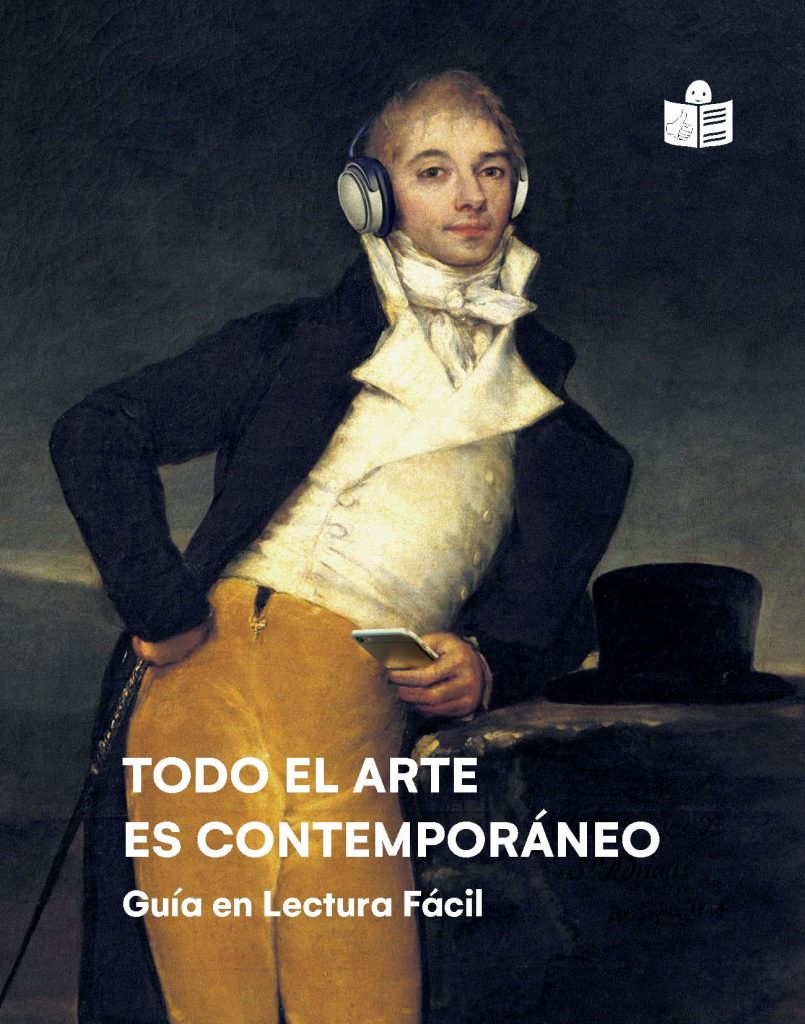Cristina Riera

Image from the website of Asociación de Lectura Fácil
This article has been written and published regarding the easy-to-read standards.
AN ACCESSIBLE MUSEUM
The Museu Nacional d’Art de Catalunya is working to improve physical, intellectual, sensory and digital access for everybody.
The museum’s objective is to guarantee equal access to culture, and to make it easy for every social group to take part.
This is stated in the Museu Nacional d’Art de Catalunya’s Strategy and Action Plan 2019 – 2022.
WHAT IS EASY-TO-READ?
The aim of Easy-to-Read is to adapt texts to make it easier for persons with reading difficulties to understand what they read.
Easy-to-Read follows the international guidelines of the IFLA (International Federation of Library Associations and Institutions) and of Inclusion Europe.
HOW DO WE KNOW THAT TEXTS ARE EASY-TO-READ?
We can identify them with different logos that tell us the texts have been adapted and/or revised by Easy-to-Read experts:
WHAT IS AN EASY-TO-READ TEXT LIKE?
. Quite short sentences, 3 lines maximum.
. Large typescript (12 to 14 point)
. Black letters on a white background.
. Wide margins and spaces between the lines.
. Short paragraphs.
. Words are not underlined.
. Italics are not used.
. Bold is used to highlight the text.
. It is better to print on matt, opaque, white paper.
. It does not use pictures as the background for text.
. It avoids capital letters because they are more difficult to read.
. It does not justify the text to the right, so that readers will not get lost when they change lines.
. Expressions are not split between two lines.
. It uses simple words. Complicated ones are explained at the bottom of the page, or with an explanatory box at the side, or a picture.
. Paragraphs are separated by blanks before and after.
. Simple punctuation marks.
. One main idea per sentence.
. It uses active forms of the verb rather than passives.
. It prefers the indicative over the subjunctive.
. There are no double negatives.
WHY SHOULD MUSEUMS USE EASY-TO-READ?
Everyone has a right to culture.
The audio descriptions and sign language guides that many museums use enable people with visual and hearing disabilities to enjoy art.
But some people still find it difficult (the elderly, people learning to read and write, migrants, people with intellectual disabilities, people with learning difficulties, children).
Museums are still lagging behind when we talk about Easy-to-Read.
There’s a long way to go.
If we want museums to be truly inclusive they have to reach everyone.
WHAT IS THE MUSEU NACIONAL D’ART DE CATALUNYA DOING?
One of its main strategic objectives is accessibility, inclusion and sustainability
It has an audio description and sign language guide service to make art more accessible.
But it wishes to take a step further and raise staff awareness. It has organized several Easy-to-Read courses for its staff.
This article for the blog is the result of that training and the first of many different Easy-to-Read steps that the museum wants to take to make art easily accessible to everyone.
WHICH MUSEUMS USE EASY-TO-READ?
. The Centre de Cultura Contemporània de Barcelona (Barcelona): CCCB’s exhibitions have a room guide in Easy-to Read. An example is Feminisms.
Image from the website of Asociación de Lectura Fácil
. The Monastery of Pedralbes (Barcelona): It has a tactile model of the monument to Queen Elisenda, with Easy-to-Read texts.
. The Museu de Ciències Naturals de Barcelona (Barcelona): All the information for the exhibition Som natura is Easy-to-Read.
. The Botanical Gardens (Barcelona): The texts on the visit are adapted to Easy-to-Read.
. The Museu Etnològic and Cultures del Món (Barcelona): It has adapted the contents through the accessible application ‘Barcelona without barriers’.
. The Museu de l’Empordà (Figueres): It adapted the contents of the exhibition Els Dalí de Figueres to Easy-to-Read.
. The Museo Nacional Thyssen-Bornemisza (Madrid): It has produced the Easy Museum guide, the first Easy-to-Read guide to the Thyssen-Bornemisza Collection.
Publicación Museo fácil, Museo Thyssen-Bornemisza, 2019
. The Museo ICO (Madrid): It has produced the Easy-to-Read educational notebook Discover, learn, imagine!

Descubre, aprendre, imagina!, Museo ICO, 2017
. The Enkarterriko Museoa / The Museo de las Encartaciones (Sopuerta-Bizkaia): It was the first museum in the Basque Country to incorporate. Easy-to-Read and content in audio format through QR codes in temporary exhibitions.

Image from the website of Asociación de Lectura Fácil
. The Museo de Navarra (Pamplona) It has the guides ‘6 Easy-to-Read works from the Museo de Navarra’ and ‘All art is contemporary’.
- 6 obras maestras del Museo de Navarra, Museo de Navarra, Ed. Calícrates
- Todo el arte es contemporáneo, Museo de Navarra, Ed. Calícrates
. The Alhambra and the Generalife (Granada): It has an Easy-to-Read information guide about its history, and for the visit to the Alhambra and the Generalife.

Ana Sánchez Peinado, La Alhambra y el Generalife en lectura fácil, Biblioteca Fundación Once, 2018
. The Museo Arqueológico de Alicante (Alicante): In 2018 it incorporated Easy-to-Read in the exhibition panels and the schoolchildren’s didactic guidebook for the exhibition Rupestre. Los primeros santuarios.
. The Alma Mater Museum (Zaragoza): It has incorporated Easy-to-Read information: room guides and internal and external signage.
. The Ministry of Culture and Sport has a project to make art accessible for people with intellectual disabilities.
What does this project consist of?
- Revision of museum maps
- Creation of specific Easy-to-Read guides
What museums can we find it in?
- Museo de América (Madrid)
- Museo Arqueológico Nacional (Madrid)
- Museo del Traje (Madrid)
- Museo Nacional de Escultura (Valladolid)
- Museo Casa de Cervantes (Valladolid)
The aim is to introduce it in 11 more museums as well.
Easy-to-Read Booklets, Museo Arqueológico Nacional
The Museu Nacional d’Art de Catalunya has begun the process to make a big change in terms of accessibility and inclusion.
VOCABULARY
IFLA: international association created to give librarians a forum to exchange ideas and to facilitate cooperation and research.
Inclusion Europe: European association of people with disabilities and their families.
Learning to read and write: people being taught to read and write.
Migrant: a person who moves from one territory to another, to settle on a temporary or a permanent basis.
Intellectual disability: an alteration that some people have which makes it difficult for them to learn, solve problems, reason, make plans…
Learning difficulty: a problem with learning that some people have.
Inclusive: which encourages everyone to take part.
Strategy: a series of actions designed to achieve a goal.
Accessible: everyone can enter.
RELATED LINKS
A touch scale model of the Queen Elisenda’s tomb. Monastery of Pedralbes
Easy-to-Read. La Alhambra y el Generalife
Easy-to-Read Booklets. Museo Arqueológico Nacional
Departament de Comunicació



















